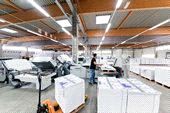Finishing & Screen Printing
New generation of Stahlfolder TX/KX folding systems from Heidelberg optimizes performance and simplifies operation in industrial production

Monday 08. July 2013 - Top-quality folding in no time at all
Aumüller print shop improves productivity by over 40 percent with Stahlfolder TX 82 folding systems and new PFX pallet feeder
Postpress bottleneck eliminated
Discerning customers in the premium segment and customers who order their print products online expect both high quality and fast delivery. This can be achieved using lean, industrialized print production with state-of-the-art technologies. The new Stahlfolder TX/KX folding systems from Heidelberger Druckmaschinen AG (Heidelberg) offer special machine configurations for high-performance industrial signature folding to meet these requirements. The key feature of these new systems is the PFX feeder (PFX = Pallet Feeder eXtended), which uses the same principle as a press feeder and offers the unique possibility of processing a stream of shingled sheets in both the feeder and the folding unit. As a result, productivity is up to 50 percent higher than in conventional production processes. The first model of this new family of folding machines – the Stahlfolder TX 82 – was unveiled as a prototype at drupa 2012.
Please find more information in the press release of May 2, 2012 “drupa 2012: New Pallet Feeder from Heidelberg Boosts Productivity in Industrial Folding by up to 50 Percent” .
The Stahlfolder TX 82 is now available in series production and has already been installed by a number of customers in Germany, the United Kingdom, and the United States. This new generation of folding systems augments the successful Stahlfolder TH/KH folding machines that, thanks to their comprehensive range of options and variants, can be configured to suit specific customer requirements.
Aumüller print shop improves productivity by over 40 percent with Stahlfolder TX 82
The Aumüller print shop in Regensburg, Germany, which offers both highly industrialized large-volume printing and complex commercial products in short runs, was impressed by the Stahlfolder TX 82 equipped with the prototype of the new PFX feeder at drupa 2012. “The potential of this machine was immediately obvious to me and we ordered two Stahlfolder TX 82 machines before the show had even finished,” says Volker Dollinger, who is in charge of the print shop and postpress activities at Aumüller. The development partnership between Aumüller and Heidelberg dates back to 1996, and the two companies agreed to field test the first machine after drupa. “The Stahlfolder TX 82 got off to a sensational start, processing 80,000 to 90,000 sheets per shift. That virtually doubled our folding output right away,” says Dollinger with obvious satisfaction. “We took delivery of the second machine in February 2013 and we now normally need one skilled operator and two assistants to operate both of them. For example, a skilled operator folded up to 155,000 sheets in A4 oblong format per shift on the two machines, compared with the previous 40,000 sheets. The effect is particularly noticeable with long runs, but equivalent increases are also achieved with shorter runs.
“Our previous folding machines were not able to process sheets at the same speed as our presses, so we needed a great deal of space for intermediate storage. That’s no longer the case. After a short pause for drying, sheets go directly into the folding machines and no longer need to be stored. This naturally enables us to cope far more effectively with extremely heavy workloads at peak times,” sums up Dollinger.
Founded in 1888, Aumüller has a customer base that includes well-known companies in the automotive and sports sectors. Over the past year alone, 130 employees have produced over 180 million sheets on six Speedmaster XL presses in the 75 x 105 centimeter (29.53 x 41.34 inch) format with a total of 52 printing units. All six presses are equipped or have been retrofitted with the Prinect Inpress Control inline measuring system that dramatically reduces paper waste by controlling color and register on the fly. “We have an exceptionally high printing capacity of up to one million sheets per day. The folding department used to be the bottleneck due to its failure to keep up with the increases in output achieved in the pressroom,” explains Dollinger. The company already has ten folding machines, most of them Stahlfolder, along with two saddlestitchers – a Stitchmaster ST 100 and an ST 400 – and an adhesive binder. Both press and postpress operations take place in three shifts.
Minimal makeready times and straightforward operation
The specially coordinated operating concept of the entire Stahlfolder TX 82 system minimizes makeready times. Many of the makeready steps normally associated with folding machines are completely eliminated. The folding machine is configured to process a wide range of fold types without time-consuming machine conversions. The folding units, including delivery, do not need to be moved during changeovers. The buckle plate and folding roller settings are performed automatically. In addition to boosting productivity, the innovative parallel fold types of the Stahlfolder TX 82 also improve fold quality and production stability, because sheets are guided through the machine far more precisely than with comparable cross-fold types.
“The two new folding machines also enable us to plan subsequent operations far more effectively. It goes without saying that it’s important to assign jobs to the right machine.
The new parallel fold types have resulted in both quantitative and qualitative improvements,” stresses Dollinger. The new fold types were adapted to Aumüller’s specific requirements to ensure optimum results. The paper formats needed to be adapted in the same way.
“We assigned our best operators to the machines from the outset. They applied the new concept and are now passing on the necessary information to other staff. This requires a major adjustment, because it involves switching from non-industrial operation to a highly industrialized and standardized approach. Folding with just two units that no longer need to be converted and form a fixed system entity is a true folding revolution in my eyes,” concludes Dollinger.
